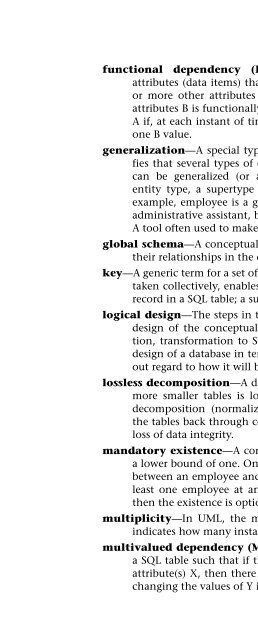- Page 2:
Database Modeling & Design Fourth E
- Page 6:
Joe Celko’s Data and Databases: C
- Page 12:
Publishing Director Michael Forster
- Page 18:
Contents Preface xv Chapter 1 Intro
- Page 22:
Contents xi 4.4.4 Merging and Restr
- Page 26:
Contents xiii Chapter 9 CASE Tools
- Page 30:
2 CHAPTER 1 Introduction In this ch
- Page 34:
4 CHAPTER 1 Introduction Informatio
- Page 38:
6 CHAPTER 1 Introduction II(b)], tw
- Page 42:
8 CHAPTER 1 Introduction tional rel
- Page 46:
10 CHAPTER 1 Introduction Customer
- Page 52:
2 The Entity-Relationship Model T h
- Page 56:
2.1 Fundamental ER Constructs 15 at
- Page 60:
2.1 Fundamental ER Constructs 17 Co
- Page 64:
2.1 Fundamental ER Constructs 19 12
- Page 68:
2.1 Fundamental ER Constructs 21 us
- Page 72:
2.2 Advanced ER Constructs 23 2.2 A
- Page 76:
2.2 Advanced ER Constructs 25 Softw
- Page 80:
2.2 Advanced ER Constructs 27 Proje
- Page 84:
2.2 Advanced ER Constructs 29 entit
- Page 88:
2.4 Literature Summary 31 2.4 Liter
- Page 94:
34 CHAPTER 3 The Unified Modeling L
- Page 98:
36 CHAPTER 3 The Unified Modeling L
- Page 102:
38 CHAPTER 3 The Unified Modeling L
- Page 106:
40 CHAPTER 3 The Unified Modeling L
- Page 110:
42 CHAPTER 3 The Unified Modeling L
- Page 114:
44 CHAPTER 3 The Unified Modeling L
- Page 118:
46 CHAPTER 3 The Unified Modeling L
- Page 122:
48 CHAPTER 3 The Unified Modeling L
- Page 126:
50 CHAPTER 3 The Unified Modeling L
- Page 132:
4 Requirements Analysis and Concept
- Page 136:
4.3 Conceptual Data Modeling 55 •
- Page 140:
4.3 Conceptual Data Modeling 57 inc
- Page 144:
4.3 Conceptual Data Modeling 59 Emp
- Page 148:
4.3 Conceptual Data Modeling 61 con
- Page 152:
4.3 Conceptual Data Modeling 63 Emp
- Page 156:
4.3 Conceptual Data Modeling 65 Div
- Page 160:
4.4 View Integration 67 Customer 1
- Page 164:
4.4 View Integration 69 nectivity c
- Page 168:
4.4 View Integration 71 Publication
- Page 172:
4.4 View Integration 73 N Publicati
- Page 176:
4.5 Entity Clustering for ER Models
- Page 180:
4.5 Entity Clustering for ER Models
- Page 184:
4.5 Entity Clustering for ER Models
- Page 188:
4.6 Summary 81 Department Division/
- Page 192:
5 Transforming the Conceptual Data
- Page 196:
5.1 Transformation Rules and SQL Co
- Page 200:
5.1 Transformation Rules and SQL Co
- Page 204:
5.1 Transformation Rules and SQL Co
- Page 208:
5.1 Transformation Rules and SQL Co
- Page 212:
5.1 Transformation Rules and SQL Co
- Page 216:
5.1 Transformation Rules and SQL Co
- Page 220:
5.1 Transformation Rules and SQL Co
- Page 224:
5.1 Transformation Rules and SQL Co
- Page 228:
5.1 Transformation Rules and SQL Co
- Page 232:
5.2 Transformation Steps 103 there
- Page 236:
5.2 Transformation Steps 105 5.2.3
- Page 240:
6 Normalization T his chapter focus
- Page 244:
6.1 Fundamentals of Normalization 1
- Page 248:
6.1 Fundamentals of Normalization 1
- Page 252:
6.1 Fundamentals of Normalization 1
- Page 256:
6.1 Fundamentals of Normalization 1
- Page 260:
6.2 The Design of Normalized Tables
- Page 264:
6.3 Normalization of Candidate Tabl
- Page 268:
6.3 Normalization of Candidate Tabl
- Page 272:
6.4 Determining the Minimum Set of
- Page 276:
6.4 Determining the Minimum Set of
- Page 280:
6.5 Fourth and Fifth Normal Forms 1
- Page 284:
6.5 Fourth and Fifth Normal Forms 1
- Page 288:
6.5 Fourth and Fifth Normal Forms 1
- Page 292:
6.5 Fourth and Fifth Normal Forms 1
- Page 296:
6.5 Fourth and Fifth Normal Forms 1
- Page 300:
6.6 Summary 137 Table 6.8 Summary o
- Page 304:
7 An Example of Logical Database De
- Page 308:
7.2 Logical Design 141 7.2 Logical
- Page 312:
7.2 Logical Design 143 create table
- Page 316:
7.3 Summary 145 Table 7.3 Decomposi
- Page 322:
148 CHAPTER 8 Business Intelligence
- Page 326:
150 CHAPTER 8 Business Intelligence
- Page 330:
152 CHAPTER 8 Business Intelligence
- Page 334:
154 CHAPTER 8 Business Intelligence
- Page 338:
156 CHAPTER 8 Business Intelligence
- Page 342:
158 CHAPTER 8 Business Intelligence
- Page 346:
160 CHAPTER 8 Business Intelligence
- Page 350:
162 CHAPTER 8 Business Intelligence
- Page 354:
164 CHAPTER 8 Business Intelligence
- Page 358:
166 CHAPTER 8 Business Intelligence
- Page 362:
168 CHAPTER 8 Business Intelligence
- Page 366:
170 CHAPTER 8 Business Intelligence
- Page 370:
172 CHAPTER 8 Business Intelligence
- Page 374:
174 CHAPTER 8 Business Intelligence
- Page 378:
176 CHAPTER 8 Business Intelligence
- Page 382:
178 CHAPTER 8 Business Intelligence
- Page 386:
180 CHAPTER 8 Business Intelligence
- Page 390:
182 CHAPTER 8 Business Intelligence
- Page 394:
184 CHAPTER 8 Business Intelligence
- Page 398:
186 CHAPTER 8 Business Intelligence
- Page 402:
188 CHAPTER 9 CASE Tools for Logica
- Page 406:
190 CHAPTER 9 CASE Tools for Logica
- Page 410:
192 CHAPTER 9 CASE Tools for Logica
- Page 414:
194 CHAPTER 9 CASE Tools for Logica
- Page 418:
196 CHAPTER 9 CASE Tools for Logica
- Page 422:
198 CHAPTER 9 CASE Tools for Logica
- Page 426:
200 CHAPTER 9 CASE Tools for Logica
- Page 430:
202 CHAPTER 9 CASE Tools for Logica
- Page 434:
204 CHAPTER 9 CASE Tools for Logica
- Page 438:
206 CHAPTER 9 CASE Tools for Logica
- Page 442:
208 CHAPTER 9 CASE Tools for Logica
- Page 446: 210 CHAPTER 9 CASE Tools for Logica
- Page 452: Appendix The Basics of SQL Structur
- Page 456: A.2 Data Definition Language (DDL)
- Page 460: A.2 Data Definition Language (DDL)
- Page 464: A.3 Data Manipulation Language (DML
- Page 468: A.3 Data Manipulation Language (DML
- Page 472: A.3 Data Manipulation Language (DML
- Page 476: A.3 Data Manipulation Language (DML
- Page 480: A.3 Data Manipulation Language (DML
- Page 484: A.4 References 229 The create view
- Page 490: 232 Glossary X and A are either sim
- Page 494: 234 Glossary entity instance (or oc
- Page 500: Glossary 237 requirements specifica
- Page 504: References Ambler, S. Agile Databas
- Page 508: References 241 Cobb, R. E., Fry, J.
- Page 512: References 243 Jajodia, S., and Ng,
- Page 516: References 245 Sakai, H. “Entity-
- Page 520: References 247 Zachmann, J. A. “A
- Page 526: 250 Exercises Assertions: • An in
- Page 530: 252 Exercises Transformation of the
- Page 534: 254 Exercises reservation_no -> dep
- Page 538: 256 Exercises 1. ABCD -> EFGHIJK 8.
- Page 542: 258 Exercises base schema. You shou
- Page 546:
260 Solutions to Selected Exercises
- Page 550:
262 Solutions to Selected Exercises
- Page 554:
264 About the Authors Tom Nadeau is
- Page 558:
266 Index Attributes (cont’d.) da
- Page 562:
268 Index Data manipulation languag
- Page 566:
270 Index Generalization, 23 comple
- Page 570:
272 Index Primary FDs (cont’d.) f
- Page 574:
274 Index Ternary relationships (co




